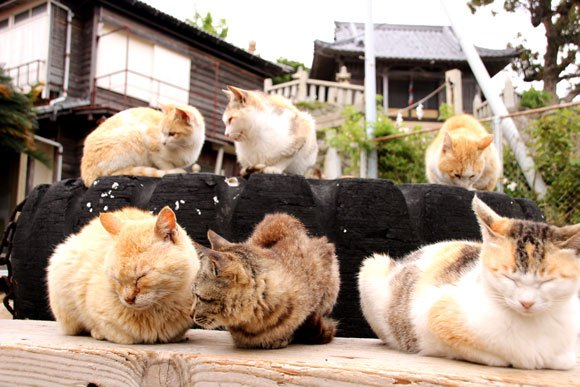
There’s a Japanese proverb, “Neko ni Koban,” that translates as “Giving a gold coin to a cat.” It’s a metaphor for offering something of worth that the recipient either doesn’t need or can’t understand the value of, but it’s also a telling example of how hard it is to win a cat’s favor. Cats have no use for our money, they’re not impressed by our fashion trends, and even if they appreciate our modern sense of humor they’re too proud to let it show by openly laughing.
With so few options, in an attempt to curry favor, some people offer stray cats food (although not, in fact, a bowl of curry). But might this be causing a problem to the residents of one of Japan’s famous cat islands?
We dispatched our Japanese-language correspondent, Meg, to find out (and also pet some kitties while she was at it).
We’ve talked before about Ehime Prefecture’s Aoshima, also known as Cat Island or Cat Paradise. With just 15 human residents and over 100 stray cats, the balance of power is definitely shifted towards the felines.
▼ The ferry to Aoshima
But while very few people live on the island, it’s become a popular tourist stop as Japan’s cute animal craze continues. Of course, if you love cats so much that you’ve come all the way to this remote island, odds are you want to do more than just look at them from a distance.
▼ There was even a cat welcoming committee waiting for us on the docks.
We’d heard rumors that an increasing number of tourists, bewitched by the cats’ beauty, had been feeding them snacks, and possibly triggering to a growing obesity problem.
In theory, this isn’t hard to imagine. Up until a few years ago, Aoshima received a relatively small number of visitors. As the island’s cats aren’t pets, they had to scavenge and hunt for food in the wild. The limited resources available meant that in order to survive, they had to eat whenever the opportunity presented itself.
As such, some are worried that the cats don’t have the willpower to resist the offer of free food from tourists, or even the concept that it’s possible to eat too much. In light of this, Meg took it upon herself to conduct a study once she arrived.
As welcoming as Aoshima is to visitors, we didn’t think they’d appreciate us carrying around a scale and weighing the animals. So instead, Meg devised a simple visual spot test.
Looking down on the cats from above, animals with a noticeable narrowing between the head and body would be classified as normal. Those that displayed a straight line would be called a “a little heavy,” and those with a rounded overhead view would be termed “overweight.”
To our relief, almost all of the cats Meg observed had normal body types. There were a few slightly heavy kitties mixed in with the slim population, but our reporter didn’t find a single truly overweight cat.
While there wasn’t time to check every cat on the island, Meg has a theory about how the ones she saw maintain their figures. “They walk with the athletic stalking motions of a wild animal,” she said. Since these aren’t house cats, they get plenty of exercise as they roam their island home, looking for food during the many times there isn’t a tourist with a handout around.
illustrating the point, during Meg’s time on Aoshima, she observed a cat catching and eating a grasshopper, which she described as cute, clearly showing where her animal preferences lie.
▼ Granted, grasshoppers this size would be terrifying
Still, it’s important to be vigilant in not tempting cats to blow past their healthy caloric intake limits. Cats can’t go to the gym to work out and burn off fat after a few weeks of over-indulging, so once they become obese, it can be hard for them to return to a healthy weight.
This is an especially difficult problem for house cats or pets in developed areas, which have far less need to naturally exercise in moving from point A to point B. Obesity has the same negative effects on the health of cats that it does on that of humans, so in order to ensure your kitty has a long and happy life, helping it stay active is a must.
Pet supply stores are stocked with towers for cats to climb on and toys to play with, both of which are healthy alternatives to offering yet another tasty but unnecessary treat when you want to make a fun connection with your pet.
Thankfully, the cats of Aoshima have enough natural opportunities to exercise that they don’t need any fancy playthings. Still, for their health, it’s probably best for tourists to adopt the “Take only pictures, leave only footprints,” philosophy, which includes not leaving any snacks for the popular felines.
▼ As a matter of fact, they’ll even help you with the “leaving footprints” part.
Photos: RocketNews24
[ Read in Japanese ]